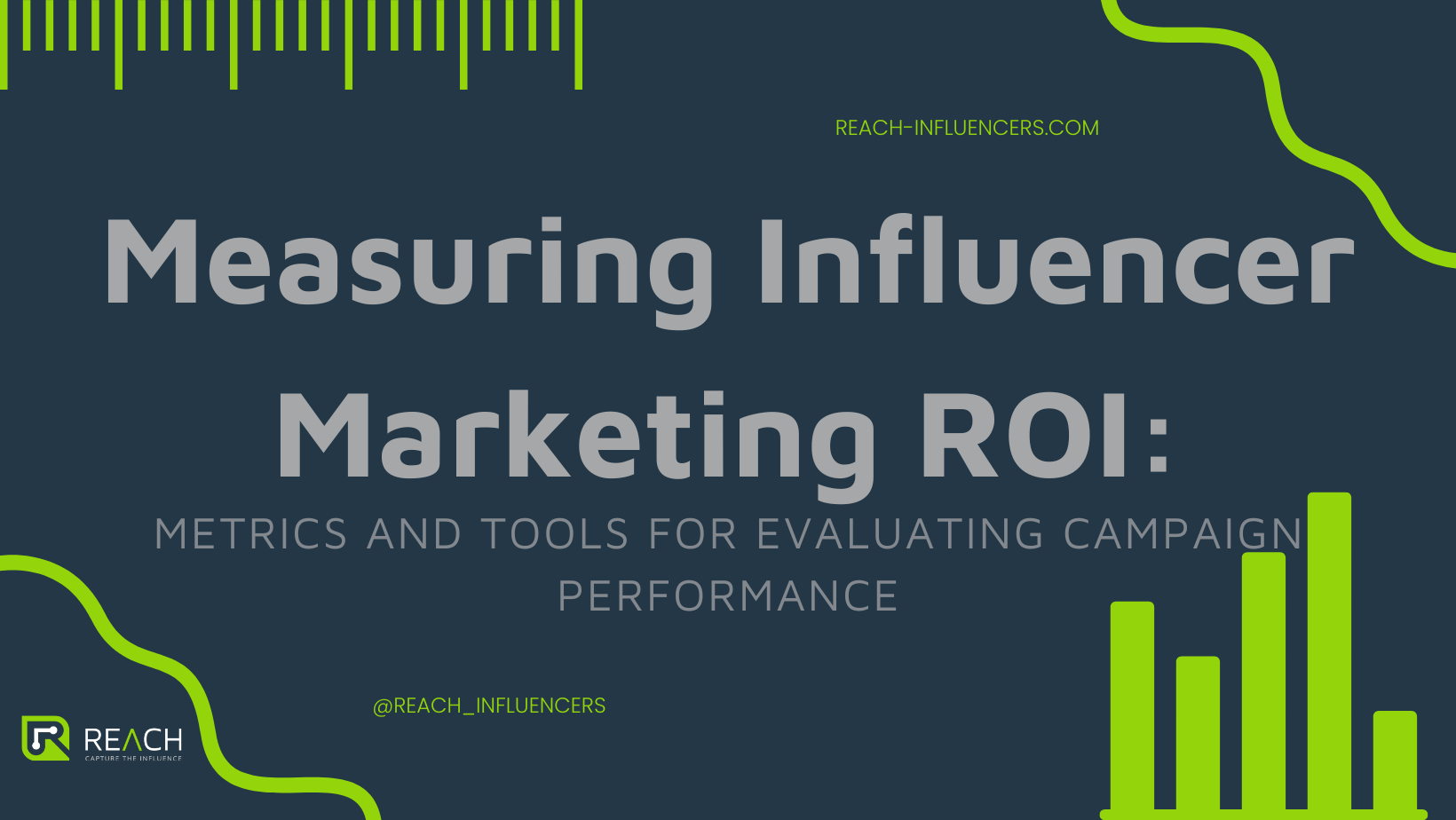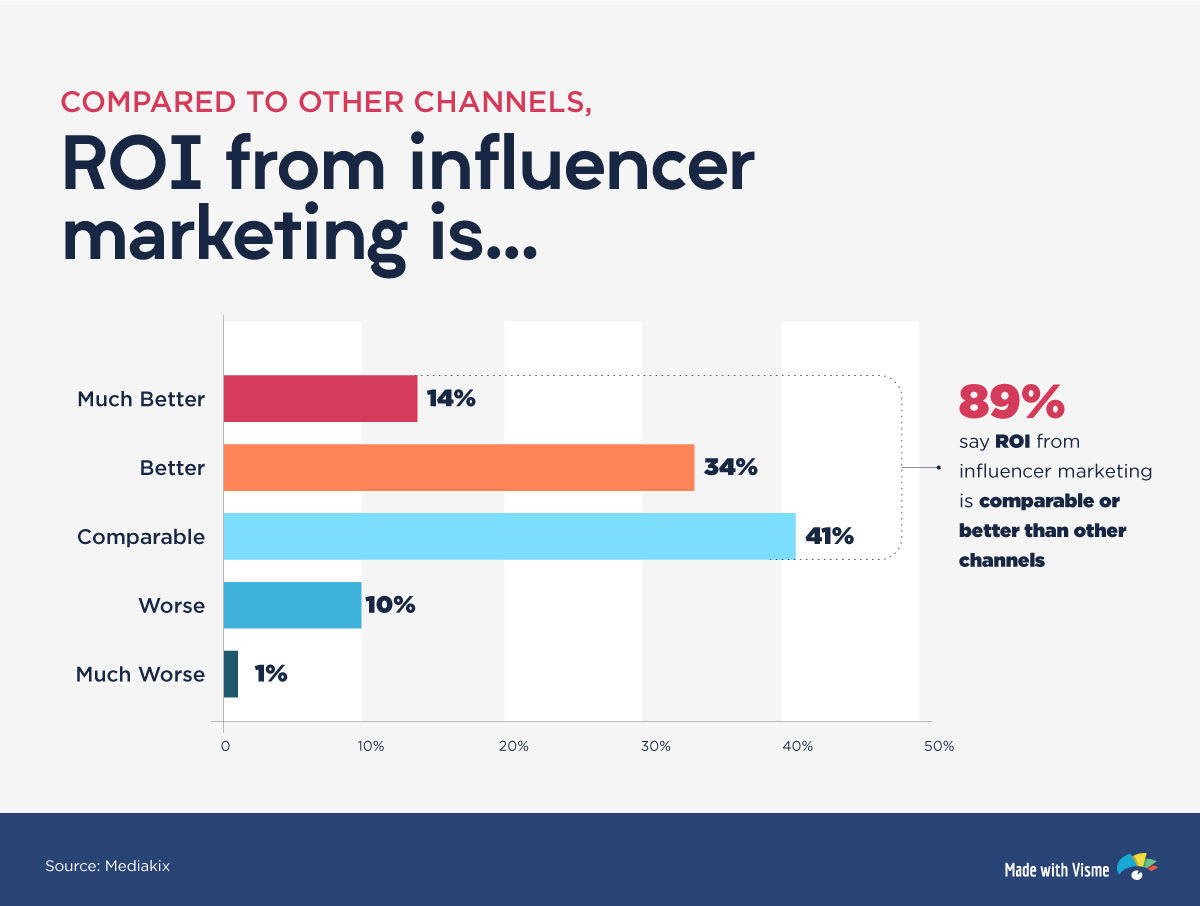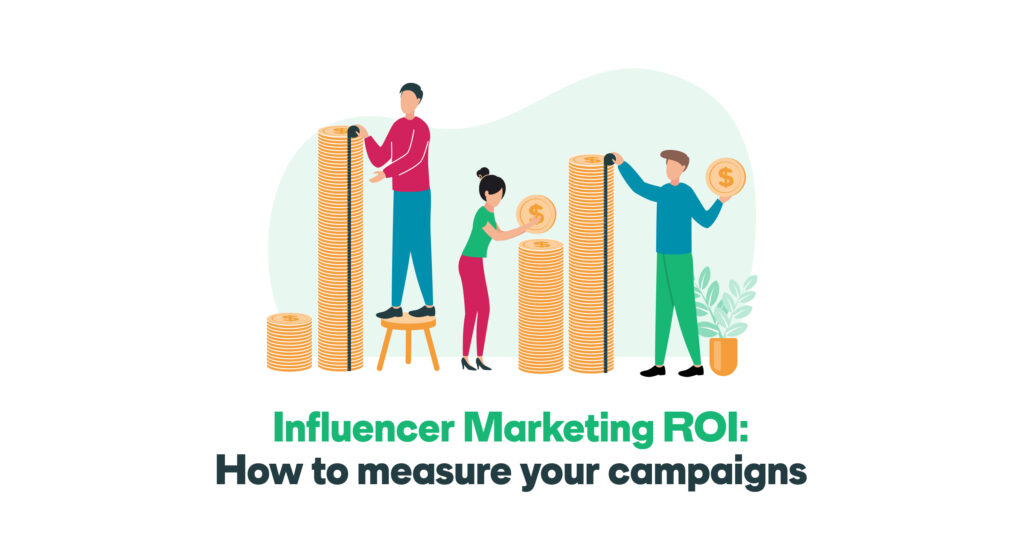Measuring ROI in influencer marketing involves comparing the revenue generated against the costs incurred. Effective metrics include engagement rates, conversion rates, and brand awareness.
Influencer marketing has become a vital strategy for brands aiming to connect with their target audience. As social media continues to evolve, businesses seek ways to quantify the impact of their campaigns. Understanding the return on investment (ROI) is crucial for optimizing marketing efforts.
Brands can assess the effectiveness of influencer partnerships by analyzing key performance indicators. This evaluation not only informs future collaborations but also helps in budget allocation. By focusing on measurable outcomes, brands can refine their strategies and achieve greater success in a competitive landscape. The right metrics can turn influencer marketing into a powerful tool for growth.
The Rise Of Influencer Marketing
Influencer marketing has rapidly transformed the advertising world. Brands now rely on influencers to connect with audiences. This method builds trust and boosts engagement. Many businesses are shifting their strategies to include influencer partnerships.
Shifting Landscapes: Traditional Vs. Influencer Marketing
Traditional marketing used mass media like TV and print. Influencer marketing focuses on personal connections through social media.
- Traditional Marketing: Expensive ad placements.
- Limited Engagement: One-way communication.
- Broad Audiences: Generic messages for everyone.
- Influencer Marketing: Cost-effective and targeted.
- High Engagement: Two-way conversations.
- Niche Audiences: Tailored messages to specific groups.
Brands now see influencers as essential partners. They help create authentic content. This change drives more effective marketing strategies.
Key Statistics: Influencer Marketing Impact
| Statistic | Impact |
|---|---|
| Influencer ROI | Over $5.78 for every $1 spent |
| Consumer Trust | 70% trust influencers over traditional ads |
| Engagement Rate | Influencers have 10x more engagement |
| Purchase Decisions | 49% of consumers rely on influencer recommendations |
These statistics highlight the effectiveness of influencer marketing. Brands using this method see higher returns. Engaging with influencers builds genuine connections with customers.
As influencer marketing grows, businesses adapt. They recognize the power of social proof. This strategy enhances brand visibility and loyalty.

Credit: reach-influencers.com
Defining Roi In Influencer Marketing
Understanding ROI in influencer marketing is crucial for brands. It helps determine the effectiveness of campaigns. ROI measures the return on investment. Knowing this guides future marketing efforts. Brands can optimize their strategies for better outcomes.
Roi Basics: What It Means For Your Brand
ROI stands for Return on Investment. It shows how much profit you make from your spending. In influencer marketing, it answers key questions:
- Did the campaign increase sales?
- Did it raise brand awareness?
- Did it grow social media engagement?
Measuring ROI helps brands assess their marketing efforts. It provides insights into which influencers work best. A successful ROI indicates effective strategies.
Quantitative Vs. Qualitative Metrics
Measuring ROI involves both quantitative and qualitative metrics. Understanding the difference is essential.
| Metric Type | Description | Examples |
|---|---|---|
| Quantitative | Numerical data that shows performance. |
|
| Qualitative | Descriptive data that shows sentiment. |
|
Both metrics provide valuable insights. Quantitative metrics show the hard numbers. Qualitative metrics reveal emotional connections. Combining both gives a fuller picture of campaign success.
Setting Clear Goals And Objectives
Setting clear goals and objectives is crucial for successful influencer marketing. Well-defined goals guide your strategy. They help measure the success of your campaigns. Without goals, it’s easy to lose focus. Establishing specific targets leads to better results.
Identifying Your Campaign Targets
Start by pinpointing what you want to achieve. Consider these common targets:
- Increase brand awareness
- Boost sales
- Grow social media followers
- Enhance website traffic
Define each target clearly. Use specific metrics to measure success.
For example:
| Goal | Metric |
|---|---|
| Increase brand awareness | Impressions or reach |
| Boost sales | Sales revenue or conversion rate |
| Grow social media followers | Follower count |
| Enhance website traffic | Website visits |
Aligning Influencer Marketing With Business Outcomes
Your goals must connect to larger business outcomes. This alignment ensures your efforts add real value. Consider these strategies:
- Link influencer campaigns to sales data.
- Monitor customer engagement on social media.
- Track website analytics for traffic growth.
Use these methods to measure ROI effectively. Ensure every campaign contributes to your business goals. This approach maximizes the impact of your influencer marketing.
Choosing The Right Influencers
Choosing the right influencers is crucial for effective marketing. The right fit can boost your brand’s visibility. It can also improve your return on investment (ROI). Understanding how to select the right influencers is key.
Criteria For Selecting Influencers
Effective influencer selection involves several criteria:
- Audience Demographics: Understand the age, gender, and location.
- Engagement Rate: Look for likes, comments, and shares.
- Content Quality: Assess the quality of their posts.
- Brand Alignment: Ensure their values match your brand.
- Authenticity: Choose influencers with genuine connections.
The Importance Of Relevance And Reach
Relevance and reach play vital roles in influencer marketing:
| Factor | Description |
|---|---|
| Relevance | Choose influencers whose content matches your brand’s message. |
| Reach | Consider the influencer’s follower count and audience size. |
High relevance ensures the message resonates with the audience. A larger reach increases exposure to potential customers.
Tracking Performance Metrics
Measuring the success of influencer marketing is vital. It helps brands understand what works. Tracking performance metrics provides insights into campaign effectiveness. This enables data-driven decisions for future strategies.
Key Performance Indicators (kpis) To Monitor
Identifying the right KPIs is essential. They help evaluate the campaign’s success. Here are some important KPIs to track:
- Engagement Rate: Measures interactions per post.
- Reach: Indicates how many people see the content.
- Impressions: Counts total views of the content.
- Click-Through Rate (CTR): Shows how many clicked links.
- Conversion Rate: Measures the percentage of visitors who take action.
Tools And Platforms For Measurement
Using the right tools simplifies performance tracking. Here are some popular options:
| Tool/Platform | Description |
|---|---|
| Google Analytics | Tracks website traffic and user behavior. |
| Hootsuite | Manages social media accounts and tracks engagement. |
| BuzzSumo | Analyzes content performance and influencer reach. |
| Sprout Social | Provides detailed social media analytics. |
| Klout | Measures social media influence and engagement. |
Choose tools based on your specific needs. Combining multiple tools enhances accuracy. Regularly review metrics to adapt strategies as needed.
Credit: www.storyclash.com
Analyzing Campaign Success
Understanding the success of an influencer marketing campaign is crucial. Metrics reveal how well campaigns perform. Brands need data to adjust strategies. Analyzing this data leads to better results.
Interpreting Data For Actionable Insights
Data interpretation helps brands see what works. Key metrics include:
- Engagement Rate: Likes, shares, and comments.
- Reach: Total number of unique viewers.
- Conversions: Actions taken, like purchases.
- Return on Investment (ROI): Profit gained from the campaign.
Use tools to track these metrics. Analyze the data regularly. Look for patterns and trends. Adjust campaigns based on findings.
| Metric | Definition | Importance |
|---|---|---|
| Engagement Rate | Interaction level with content | Indicates audience interest |
| Reach | Unique users who see the content | Measures brand visibility |
| Conversions | Actions taken post-campaign | Shows effectiveness of the campaign |
| ROI | Profit from marketing spend | Assesses overall campaign success |
Case Studies: Successful Influencer Campaigns
Real-life examples illustrate effective strategies. Here are a few standout campaigns:
- Brand A: Used micro-influencers. Achieved a 25% increase in sales.
- Brand B: Partnered with a popular influencer. Gained 50,000 new followers in one month.
- Brand C: Launched a challenge campaign. Increased engagement by 40%.
These examples show the power of influencer marketing. They highlight the importance of choosing the right influencer.
Optimizing Strategies For Better Roi
Measuring ROI in influencer marketing is crucial. Optimizing strategies can significantly enhance your results. Focus on data-driven decisions. Leverage insights to refine your approach. This leads to improved engagement and conversions.
Adjusting Tactics Based On Performance
Performance data reveals what works. Analyze metrics like:
- Engagement rates
- Conversion rates
- Reach and impressions
- Click-through rates
Use these insights to adjust your tactics. For example:
- Shift budget to high-performing influencers.
- Change content types based on audience response.
- Refine posting times for better visibility.
Continuously track metrics to stay aligned with your goals. Regular adjustments can lead to significant ROI improvements.
A/b Testing: Refining Your Approach
A/B testing is vital for optimization. Test different strategies to find the best ones. Here are some effective elements to test:
| Element | Test Variation A | Test Variation B |
|---|---|---|
| Content Type | Video | Image |
| Call to Action | Shop Now | Learn More |
| Influencer Style | Authentic | Polished |
Collect data from each variation. Analyze results to determine the most effective approach. This process can reveal what resonates with your audience.
Regular A/B testing helps you stay relevant. Adjust campaigns based on findings. Better strategies lead to improved ROI.
Future Trends In Influencer Marketing
The world of influencer marketing is changing rapidly. Brands and influencers adapt to new technologies and audience behaviors. Understanding future trends helps companies stay ahead. Here are key predictions and technologies shaping this landscape.
Predictions For Influencer Marketing Evolution
Influencer marketing will continue to evolve. Here are some important predictions:
- Increased Authenticity: Audiences value genuine connections. Influencers who are real and relatable will thrive.
- Micro and Nano Influencers: Smaller influencers offer higher engagement rates. Brands will focus more on these creators.
- Greater Regulation: Transparency will be essential. Clear guidelines on sponsored content will emerge.
- Performance-Based Compensation: Brands will pay based on measurable results. ROI will dictate partnerships more than ever.
Incorporating Emerging Technologies
New technologies will transform influencer marketing strategies. Key technologies include:
| Technology | Description |
|---|---|
| Artificial Intelligence | AI will help brands analyze influencer performance. |
| Augmented Reality (AR) | AR experiences will engage users in new ways. |
| Blockchain | Blockchain will ensure transparency in transactions. |
| Virtual Reality (VR) | VR will create immersive brand experiences. |
Incorporating these technologies will enhance campaigns. Brands that adapt quickly will succeed.
Maximizing Roi With Authentic Partnerships
Building authentic partnerships in influencer marketing boosts your return on investment (ROI). Authenticity builds trust. Trust leads to better engagement and higher sales. This section explores how to maximize ROI through genuine relationships.
The Role Of Authenticity In Influencer Marketing
Authenticity is key in influencer marketing. Audiences can spot insincerity easily. Here’s why authenticity matters:
- Trust: Consumers trust real influencers.
- Engagement: Authentic content drives more likes and shares.
- Brand Loyalty: Genuine partnerships create loyal customers.
To ensure authenticity, choose influencers who align with your brand values. This alignment fosters natural promotion. Influencers should genuinely like your products.
Long-term Collaborations Vs. One-off Campaigns
Choosing between long-term partnerships and one-off campaigns is crucial. Each approach has distinct advantages:
| Type | Advantages |
|---|---|
| Long-term Collaborations |
|
| One-off Campaigns |
|
Long-term partnerships often yield higher ROI. They develop stronger brand affinity. One-off campaigns can boost visibility quickly. Choose the approach that fits your goals.

Credit: blog.keyscouts.com
Leveraging User-generated Content
User-generated content (UGC) is a powerful tool in influencer marketing. It builds trust and boosts engagement. Brands benefit from authentic content created by their audience. This section explores how to measure ROI through UGC.
Capitalizing On Audience Engagement
Engagement is vital for successful influencer campaigns. UGC enhances interaction with the audience. Here are some ways to capitalize on audience engagement:
- Encourage participation: Run contests or challenges.
- Share user stories: Highlight customer experiences.
- Utilize hashtags: Create specific tags for your brand.
- Engage with comments: Respond to user posts actively.
These strategies create a vibrant community. They foster loyalty and increase brand visibility.
Ugc As A Measure Of Campaign Effectiveness
Measuring UGC helps evaluate campaign success. Track the following metrics:
| Metric | Description | Importance |
|---|---|---|
| Engagement Rate | Likes, shares, and comments on UGC | Shows audience interest |
| Conversion Rate | Sales generated from UGC | Measures direct impact on revenue |
| Brand Mentions | Frequency of brand tags in UGC | Indicates brand awareness |
| Sentiment Analysis | User feelings expressed in UGC | Assesses brand perception |
These metrics provide valuable insights. They help refine future campaigns and enhance strategies.
Legal Considerations And Transparency
Influencer marketing has grown rapidly. Legal rules now shape this industry. Brands must ensure compliance. Transparency builds trust with audiences. Understanding these aspects is crucial for success.
Understanding Compliance And Disclosure
Regulatory bodies enforce strict rules. Influencers must disclose paid partnerships. This keeps marketing honest and clear. Here are key compliance points:
- FTC Guidelines: Follow Federal Trade Commission rules.
- Clear Language: Use simple words like “ad” or “sponsored.”
- Placement: Place disclosures at the beginning of posts.
Failure to comply can lead to fines. Brands may face reputational damage. Always prioritize transparency in campaigns.
Building Trust Through Transparent Practices
Trust is vital for influencer marketing. Transparency helps brands connect with audiences. Here are effective strategies:
- Authenticity: Choose influencers who align with your brand.
- Open Communication: Keep discussions clear and honest.
- Feedback: Encourage audience feedback on campaigns.
Transparency fosters loyalty. Audiences appreciate honesty. Brands that practice transparency gain a competitive edge.
| Practice | Benefit |
|---|---|
| Clear Disclosures | Builds trust and credibility. |
| Authentic Partnerships | Enhances audience connection. |
| Open Communication | Encourages audience engagement. |
Calculating The True Roi
Measuring the return on investment (ROI) in influencer marketing is essential. It shows how effective your campaigns are. Knowing the true ROI helps brands make smart decisions. This section dives into the formula and other important factors.
The Formula For Influencer Marketing Roi
The basic formula for calculating ROI is straightforward:
ROI = (Net Profit / Cost of Investment) x 100To break it down:
- Net Profit: Total revenue from the campaign minus total expenses.
- Cost of Investment: All costs related to the influencer campaign.
Here’s a simple example:
| Item | Amount ($) |
|---|---|
| Revenue Generated | 10,000 |
| Cost of Campaign | 2,000 |
| Net Profit | 8,000 |
Using the formula:
ROI = (8,000 / 2,000) x 100 = 400%This means you earned 400% on your investment. A high ROI indicates success.
Beyond The Numbers: Evaluating Brand Sentiment
ROI isn’t just about the numbers. Brand sentiment plays a big role. It reflects how people feel about your brand after a campaign.
Here are ways to measure brand sentiment:
- Social Media Mentions: Track how many times your brand is mentioned.
- Engagement Rates: Look at likes, shares, and comments.
- Surveys: Ask customers how they feel about your brand.
Tools like sentiment analysis software can help. They analyze comments and feedback. Understanding brand sentiment helps improve future campaigns.
Combining ROI numbers and brand sentiment gives a complete picture. It helps brands understand the true impact of their influencer marketing efforts.
Frequently Asked Questions
What Is Influencer Marketing Roi?
Influencer marketing ROI measures the effectiveness of your campaigns. It quantifies the return on investment generated from collaborations with influencers. By analyzing metrics like sales, engagement, and brand awareness, businesses can determine the financial success of their influencer strategies.
How To Calculate Influencer Marketing Roi?
To calculate influencer marketing ROI, use this formula: (Revenue – Costs) / Costs x 100. Start by determining the total revenue generated from the campaign. Subtract the costs involved, including influencer fees and product expenses, to find your ROI percentage.
This helps assess the campaign’s overall success.
Why Is Measuring Influencer Roi Important?
Measuring influencer ROI is crucial for evaluating effectiveness. It helps businesses understand which strategies yield the best results. By analyzing ROI, brands can optimize future campaigns, allocate budgets wisely, and build stronger relationships with influencers for maximum impact.
What Metrics Indicate Influencer Marketing Success?
Key metrics for influencer marketing success include engagement rate, reach, and conversions. Engagement measures how actively the audience interacts with content. Reach indicates how many people see the posts. Conversions track the actual sales or actions taken as a result of the campaign.
Conclusion
Measuring ROI in influencer marketing is essential for any brand. Accurate metrics help businesses understand their effectiveness and drive strategy. By focusing on engagement, conversions, and overall reach, marketers can optimize their campaigns. Embracing these measurements leads to better partnerships and improved results, ultimately enhancing brand visibility and growth.



